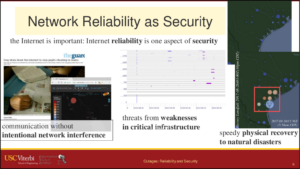John Heidemann gave the talk “Internet Outages: Reliablity and Security” at the University of Oregon Cybersecurity Day in Eugene, Oregon on April 23, 2018. Slides are available at https://www.isi.edu/~johnh/PAPERS/Heidemann18e.pdf.

From the abstract:
The Internet is central to our lives, but we know astoundingly little about it. Even though many businesses and individuals depend on it, how reliable is the Internet? Do policies and practices make it better in some places than others?
Since 2006, we have been studying the public face of the Internet to answer these questions. We take regular censuses, probing the entire IPv4 Internet address space. For more than two years we have been observing Internet reliability through active probing with Trinocular outage detection, revealing the effects of the Internet due to natural disasters like Hurricanes from Sandy to Harvey and Maria, configuration errors that sometimes affect millions of customers, and political events where governments have intervened in Internet operation. This talk will describe how it is possible to observe Internet outages today and what they are beginning to say about the Internet and about the physical world.
This talk builds on research over the last decade in IPv4 censuses and outage detection and includes the work of many of my collaborators.
Data from this talk is all available; see links on the last slide.
